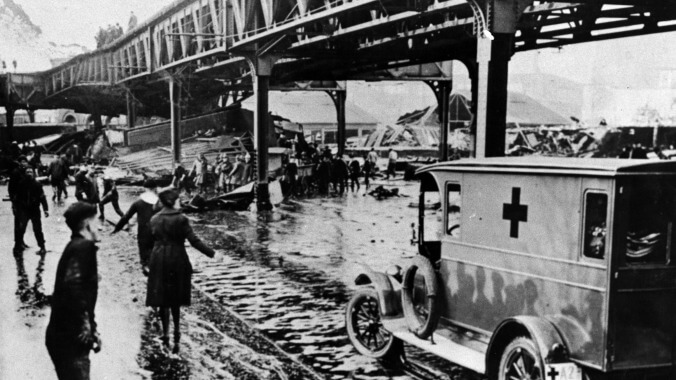The Great Boston Molasses Flood of 1919 was faster than you’d think

This week’s entry: Great Boston Molasses Flood
What it’s about: An Onion article come to life, as the North End of Boston was engulfed by molasses on a fateful January day in 1919 when a 12,000-ton tank filled with the liquid burst, sending a tidal wave of sweet, sticky disaster through the neighborhood. Streets were flooded as much as 2 or 3 feet deep, buildings were damaged, and several people and animals were killed.
Biggest controversy: It’s not clear exactly what caused the disaster. The 2.3-million-gallon tank burst with enough force that a few of the tank’s steel panels hit the girders holding up an elevated train and knocked a streetcar off the tracks. It’s possible a rapid change in temperature caused the molasses to expand—it was freezing the day before, but got up to 40 degrees, and a ship had just added a fresh load of molasses, which had been warmed to make it easier to transfer. It’s also possible the molasses began to ferment (not unusual, as besides being a sweetener and baking ingredient, molasses is used to produce ethanol, and the tank was owned by the Purity Distilling Company) and the resulting carbon dioxide raised the pressure inside the tank until it burst.
Wikipedia also says that the “tank was constructed poorly and tested insufficiently,” groaned each time it was filled, leaked so frequently that locals would stop by and collect leaked molasses instead of buying it at the store, and was painted brown to hide the leakage. Because it had only been filled to capacity a handful of times, the walls of the tank had suffered “under an intermittent, cyclical load” and were half as thick as they should have been, “even with the lax standards of the day.”
The tank was also likely filled to capacity on that fateful day, as Purity was “trying to out-race Prohibition” and distill as much molasses as they could, as the 18th Amendment was ratified the day after the disaster (although it wouldn’t take effect for another year).
Strangest fact: This isn’t history’s only molasses spill. In 2013, the Honolulu Molasses Spill saw 1,400 tons of molasses flood from a burst pipe. In this instance, there were no human casualties, as all of the molasses spilled into Honolulu Harbor, but the spill was devastating to sea life, as the molasses quickly sank to the bottom and caused deoxygenation, killing 26,000 fish and damaging the harbor’s coral.
Thing we were happiest to learn: For the survivors, at least, there was a pleasant aftermath. While the flood damaged the neighborhood, a sweet smell pervaded the North End for decades after the disaster. Journalist Edwards Park called the smell part of “a distinctive, unmistakable atmosphere of Boston.” The tank wasn’t rebuilt; instead the site of the accident was turned into a rail yard for the same elevated train damaged by the wave. Eventually the city turned the lot into Langone Park, with a playground, ballfields, and bocce courts, as well as a plaque commemorating the disaster.
Thing we were unhappiest to learn: As absurd as a wave of molasses flooding the streets may sound, it was a legitimate tragedy. One hundred fifty people were injured and 21 were killed, either drowned in molasses or hit by debris that was swept up in the wave. The Boston Post gave a sobering report: “Here and there struggled a form—whether it was animal or human being was impossible to tell… Horses died like so many flies on sticky fly-paper. The more they struggled, the deeper in the mess they were ensnared. Human beings—men and women—suffered likewise.” A 1983 Smithsonian article described a child who was caught up in a wave of molasses that “rolled him like a pebble… He heard his mother call his name and couldn’t answer, his throat was so clogged with the smothering goo.” He survived, but not everyone caught up in the wave did—fatalities ranged in age from 78-year-old messenger Michael Sinnott to two 10-year-old children, Maria Di Stasio and Pasquale Iantosca. (Wikipedia lists the names and ages of everyone killed in the accident.)
Best link to elsewhere on Wikipedia: A foodstuff-related flood with a happier ending was the Pepsi Fruit Juice Flood, in which the roof of a PepsiCo warehouse in Lebedyan, Russia collapsed, sending 7.4 million gallons of fruit and vegetable juices into the streets and a nearby river. Thankfully, there were no deaths or environmental damage to the river, and PepsiCo offered to pay for all the resulting damages.
Further down the Wormhole: One more structural defect in Purity’s molasses tank was its rivets. Well before the flood, cracks could be seen around the rivet holes, and when the tank burst, passersby reported “a sound like a machine gun as the rivets shot out of the tank.” Rivets are usually associated with heavy industry and construction, but they’re also used in the more delicate work of making jewelery. People have been wearing decorative ornaments on the body since time immemorial, often of precious metal, but any material can be turned into jewelery, even living things. We’ll take a look at the fascinating and somewhat creepy practice of live insect jewelry next week.